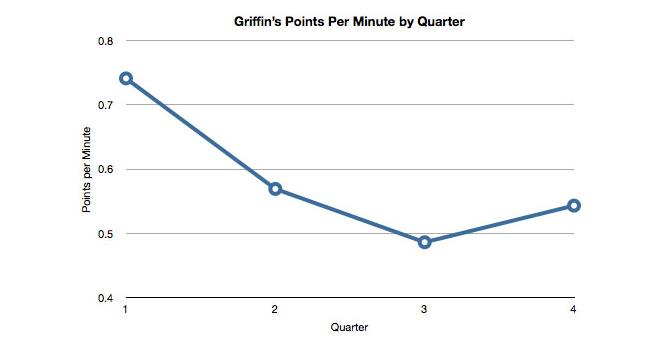Superhuman?
Blake Griffin struggles to sustain dominance throughout games.
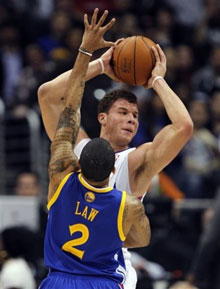 Did he just do what I think he did?
Did he just do what I think he did?
Blake Griffin has performed unbelievable feats in his inaugural season in the NBA. The 21-year-old power forward’s game exudes a style unparalleled by anyone in the Association. The aforementioned statement is quite evident even though the young man has merely played 36 games into his NBA career.
He truly is one of a kind.
Still, where the high-flyer showcases style and flare, he backs it up with substance. Griffin currently finds himself third in the League in rebounding and top 15 in scoring. Even more impressive, Griffin has recorded 23 consecutive double-doubles. By his standards, Griffin has only had seven “off games,” where he did not achieve a double-double. Along with 22-year-old Eric Gordon, he is carrying a young, depleted Clippers’ team, on his broad, muscular shoulders.
Griffin plays a specific brand of basketball that leaves coaches drooling. Pardon the cliché, but he always gives 100 percent. Unfortunately, that quality has occasionally gotten Griffin into serious trouble. For instance, he was forced to miss the entire ‘09-10 NBA season when he injured his kneecap on a ferocious dunk during the preseason. Whether it’s exhibition or the real thing, this guy will go all out.
Not surprisingly, this mindset has made him the dominant player he is today. Griffin’s enthusiastic play has produced dozens of viral videos to the point that he is recognized by casual NBA fans, as well. More importantly, his extraordinary will to win and “never-take-a-play off” approach is contagious. Although the Clippers find themselves near the bottom of the Western Conference, the squad has won seven of its last 10. Plus, Griffin scores nearly 24 points per game on 60 percent shooting in Clipper victories. In wins, he grabs over 13 boards per contest. In a sense, it appears as though Blake Griffin has the ability to will his team to win.
Unfortunately, there is a costly drawback to the 6-10 forward’s style of play.
He tires himself out.
The former Oklahoma Sooner dominates the first quarter on a regular basis, only to see his performance decline the remainder of the game. Of course, we realize that Blake Griffin’s not as impressive second through fourth quarters are better than most guys’ usual efforts. Still, Griffin’s post-first quarter decline is still a very tangible problem.
The impressive rookie scores 37 percent of his points in the first quarter. After that first period, his offensive output decreases drastically. Take a look:
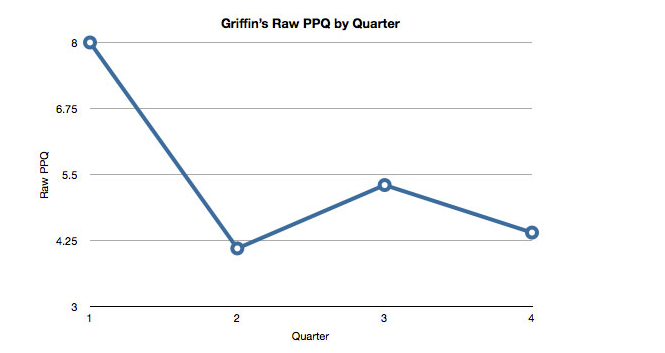 One might argue that Griffin scores so many points in the first quarter because he plays a great deal of minutes early in games. Here, we control for that by calculating the points Griffin scores per minute played (in each quarter). In other words, we are measuring scoring rate, irrespective of the big man’s playing time per quarter. Again, his first quarter performance dominates relative to the other three quarters. Griffin is the weakest, according to this measure, in the third quarter of games. We graph his quarterly performance below:
One might argue that Griffin scores so many points in the first quarter because he plays a great deal of minutes early in games. Here, we control for that by calculating the points Griffin scores per minute played (in each quarter). In other words, we are measuring scoring rate, irrespective of the big man’s playing time per quarter. Again, his first quarter performance dominates relative to the other three quarters. Griffin is the weakest, according to this measure, in the third quarter of games. We graph his quarterly performance below:
Below, we see once again that Griffin performs the best in the first quarter when his legs are most fresh. Although Griffin’s shooting percentage increases from the third to fourth quarter, it never comes anywhere close to its first quarter level. Observe: 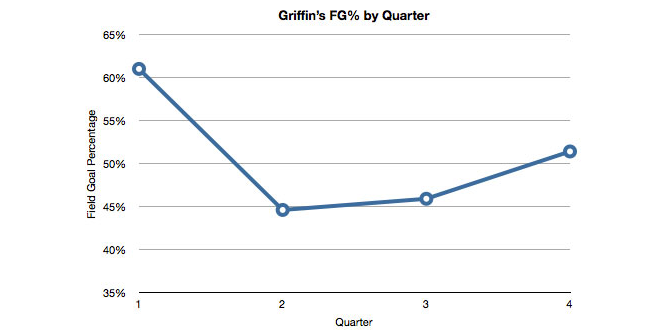
The way Blake Griffin soars through the air, one could easily assume that he possesses an infinite supply of energy; that the laws of gravity and fatigue do not apply to this godlike figure. Such thinking is clearly misguided. He is human like the rest of us, as evidenced by the aforementioned data.
One obvious reason for Griffin’s offensive decline through the progression of games is his energetic style of play. He puts a great deal of energy into his acrobatic slam dunks, and many people forget that he also brings the ball up the floor from time to time. In addition, Griffin plays a whole lot of minutes. He logs the most minutes of any rookie at a clip of 37.1 minutes per game (John Wall is second with 36.3). In fact, only three rookies including Griffin even play over 30 minutes per night (Landry Fields of the Knicks is the third).
In addition, no center plays more than Blake Griffin and only four power forwards log more minutes than the 6-10 Clipper. Of those four power forwards who are slightly ahead of Griffin in minutes played, only Amar’e Stoudemire comes close to playing such a physically taxing game. The others, LaMarcus Aldridge, Jeff Green and Pau Gasol are more finesse players, so they can afford to log more minutes (Gasol being the most physical, but still a lot less than Griffin and Stoudemire).
Finally, all minutes are not created equal. Because of Griffin’s aggressive play, he attempts 8.4 free-throws per game, ranking seventh in the League in trips to the charity stripe. Oftentimes, opponents foul violently in order to avoid appearing on the latest Blake Griffin poster or worse…the most recent viral video. A Blake jam is more than just two points against one’s team; it is commonly taken as a blow to one’s pride, though it need not be. Getting dunked on by Griffin has become exceedingly difficult to avoid. But anyway, such hard fouls incurred at great regularity, really take a toll on Griffin and can partially explain why his offensive numbers decline over the course of a game.
Thankfully for Blake Griffin and the Clippers, there’s another star player on the team: Eric Gordon, who turned 22 this past Christmas, carries a sizable portion of the Clips’ scoring load at a clip of 23.5 per game. The undersized two-guard out of Indiana was good last season, but he really came of age during the 2010 FIBA World Championships. Gordon (a.k.a. EJ), a notoriously slow starter, happens to perform the best when the rest of his team struggles most. Seemingly the antithesis of Griffin, Gordon’s shooting percentage actually skyrockets in the fourth quarter compared to earlier in the game. 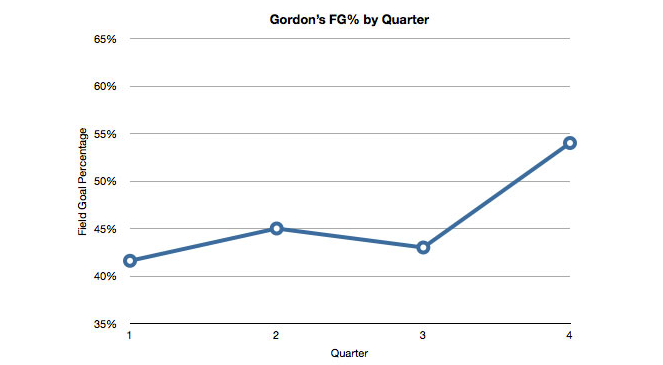
The difference between the Clippers’ two stars can be further illustrated by examining their point per minute output by quarter, side by side. Below we see that their respective scoring paths take nearly opposite trajectories. Unlike Griffin, who performs best early on, Gordon’s output increases steadily as the game progresses. 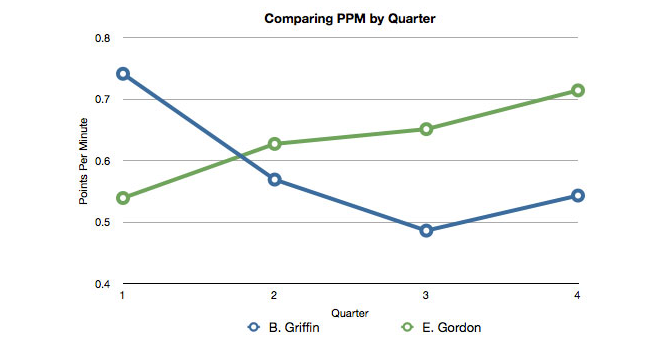
Griffin and Gordon score a combined 46.4 percent of their team’s points, yet they have only lived on this planet for a combined 43 years. And we saw above that in the quarters where one struggles (relatively speaking, of course), the other more than picks up the slack. In this sense, the two are a perfect tandem, complementing each other like few other teammates in this league. But, as we all know, basketball is not only played with two players. 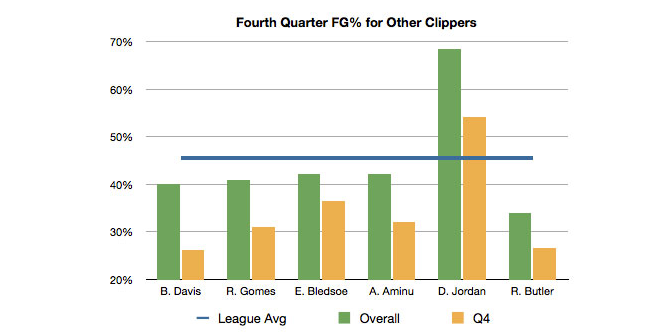
Though Eric Gordon performs spectacularly at the end of games, it doesn’t make up for the fact that every single one of the Clippers’ top six scorers after Griffin and Gordon sees his shooting percentage take a precipitous dive in the fourth quarter compared to the rest of the game. When this is taken into consideration, it is no wonder why the Clippers have already blown five third quarter leads in this young season. On top of that, they have already failed to hold on to three halftime leads to the comeback happy Utah Jazz, let slip a six-point advantage going into the fourth quarter against the in-house rival Lakers, and managed to turn an 11-point halftime lead into a nine-point loss to the high-flying Hawks.
To conclude, we are in no way, shape, or form, blaming Blake Griffin for the Clippers’ early struggles. First of all, the Clippers are still owned by inept Donald Sterling. Secondly (and related to the first reason), the team possesses a history and culture of losing. With time, they can turn it around, but for so many years the “other Staples Center inhabitants” as they’ve come to be known, have seemingly accepted losing as natural. Well, Blake Griffin has started to change this mindset. This guy wants to win badly. Every single fourth quarter meltdown eats away at Griffin, who was visibly upset after their one-point loss to the Lakers, for example.
While our statistics show that Griffin’s offensive output sharply declines after the first quarter, this team would be nowhere without him. Blake Griffin and Eric Gordon are essentially the gas that fuels this team. Rookies Eric Bledsoe and Al-Farouq Aminu have shown flashes of potential, but they are especially prone to mistakes due to inexperience. Baron Davis is a shell of his former self despite the fact that he can still connect on the alley-oop (though it’s not too hard when high-flyers Blake Griffin and DeAndre Jordan are the recipients). Chris Kaman is always injured, and Rasual Butler and Ryan Gomes are extremely inconsistent.
What we are saying is that there is an extraordinary amount of pressure placed on these two players (Blake Griffin and Eric Gordon), who are 21 and 22 years old, respectively. While it is true that Blake Griffin needs to find a way to parlay his strong offense into the second half, he is merely a rookie and it’s not completely fair to set expectations that are through the roof…even if he seems to touch the Staples Center roof multiple times every home game.
Co-written by Aaron Fischman and Loren Lee Chen originally for Slam Online.



